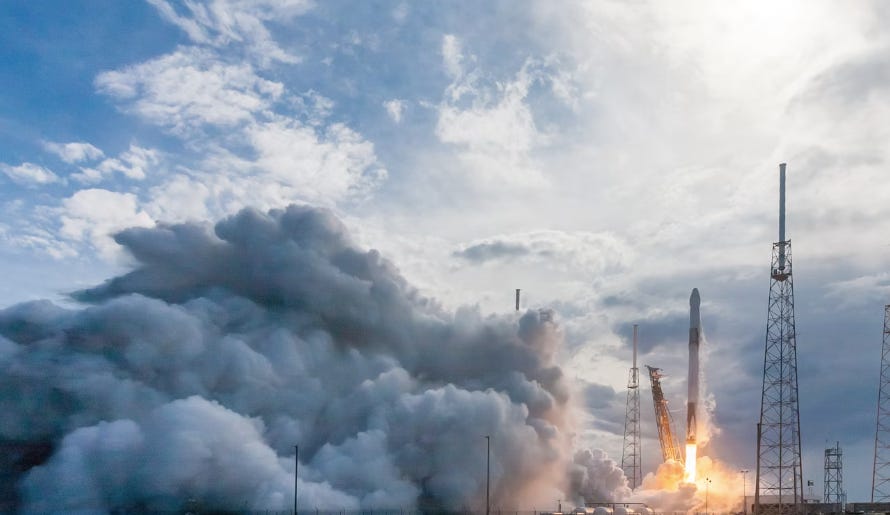Intel's mess, SpaceX's shiny new valuation, and the two-horse AI race
Welcome to Cautious Optimism, a newsletter on tech, business, and power.
📈 Trending Up: Microsoft self-dealing? … Weird reality-holes in LLMs … doing the bare minimum, years later … dirtfare … rejection … investor expectations …
My former TechCrunch colleague Ron Miller got a gig in venture and has a new blog and newsletter you might want to check out!
📉 Trending Down: The South Korean economy? … the Fed’s balance sheet, now under $7T … EU defensetech … GM’s battery chops … AT&T’s share count … the value of RMB …
Cleanup, aisle Intel
There is so much fucking excitement in the chips space today that investors are firing capital cannons at upstarts vying to snag a piece of future market share. While Intel melts before our eyes (CO wrote on Intel’s messy present a few months ago), creative destruction is long-term-helpful, short-term-painful. But, from old comes new.
As Intel’s CEO left the building, Tenstorrent closed $693M+ of Series D funding led by Samsung Securities and AFW Partners.
Now I don’t know if Tenstorrent’s Tensix processors and various configuration offerings are the future. But I do know it’s not the only chipmaker making moves.
Rebellions just got its merger done; Etched raised $120 million earlier this summer (with its focus on transformer-specific workloads); Cerebras Systems is trying to go public (it sells lots of chips to G42); Groq is building LPUs (language processing units); SambaNova is building RDUs (reconfigurable dataflow units); and Amazon, Microsoft, and Google are each building their own chips.
Unless the next Intel CEO has something up their sleeves, its continued existence looks like a legacy provider of tech built for past computing waves.
Musk-a16z Admin Watch
Bloomberg’s Katie Roof has a scoop up this week that is worth your eyes:
SpaceX is considering a secondary offering at a valuation of $350 billion, up from the $255 billion figure “as reported by Bloomberg News and other media outlets just last month.”
Roof and colleague Gillian Tan add that the possible “valuation surge underscores the enormous gains that Musk’s empire has seen since the US presidential election. Tesla Inc.’s shares are up 42% since Nov. 5, while Musk’s own wealth has soared to about $353 billion[.]”
A few things matter here. First, it is incredibly true that while SpaceX is sending more and more rockets to space over time, Blue Origin is still working on sub-orbital launches. Though to its credit, its cadence is accelerating.
From that perspective, a towering valuation premium between Blue Origin and SpaceX makes good sense. But SpaceX’s valuation gain in the last month is not due its discrepant progress compared to the Bezos-backed rival space program. To the contrary, we should consider SpaceX’s valuation now — per Bloomberg — compared to the same figure a month ago. A $100 billion gain is not a small boost to its worth. It’s about 40%. Or, more than 1% per day.
That’s quick appreciation. It is so quick I doubt it’s predicated on a breakthrough or other internal technological hinge point. Instead, the +$100 billion valuation move smells like market-anticipated regulatory capture now that Musk is best friends with Trump, whom he bet his capital and personal reputation on. Businesspeople don’t spend nine-figures on something without expecting juicy ROI. The market is saying they expect Musk to get paid back.
The global AI rush is a two(ish)-horse race
Prequin data reported by the FT indicate that “the US accounts for 83 per cent of the amount of VC funding in G7 economies over the past decade,” and “attracted 14.6 per cent of the world’s overall greenfield foreign direct investment in the first 10 months of 2024” as Germany hit its lowest level in the same metric in nearly two decades.
At the same time, a Chinese economist’s surprisingly candid — and yet to be censored — speech decrying the plight of young workers in the country included the following riff (Bloomberg translation summary):
In another bold statement, Gao estimated that China’s gross domestic product may have been over-counted by 10 percentage points over the past three years, based on his analysis of the discrepancy between data on economic growth and the expansion in areas like consumption, investment and the labor force.
Well, yes, we’ve all thought that. I simply do not understand why, in China, he’s being allowed to say that. But it’s welcome to hear, and it is good news that we are able to do so.
It’s a bit apples:oranges to compare the United States’ venture capital dollar share amongst the G7 to Chinese youth and aggregate economic health, but I doubt that my point is hard to grok. Not that China is not investing in AI and semiconductors and the like — it is — but the comparative dynamism for the youth economy in the United States viz startups and China is increasingly noticeable. For example, the share of global venture dollars that China-based startups raise is shrinking rapidly. That’s not how you win the future.
You could argue the success that Chinese technology incumbents are seeing with LLMs is indicative of market health in the country. It is, at least to some degree. But if you had to bet on winning the AI future, would you rather bet on OpenAI and xAI and Anthropic, or Baidu?

